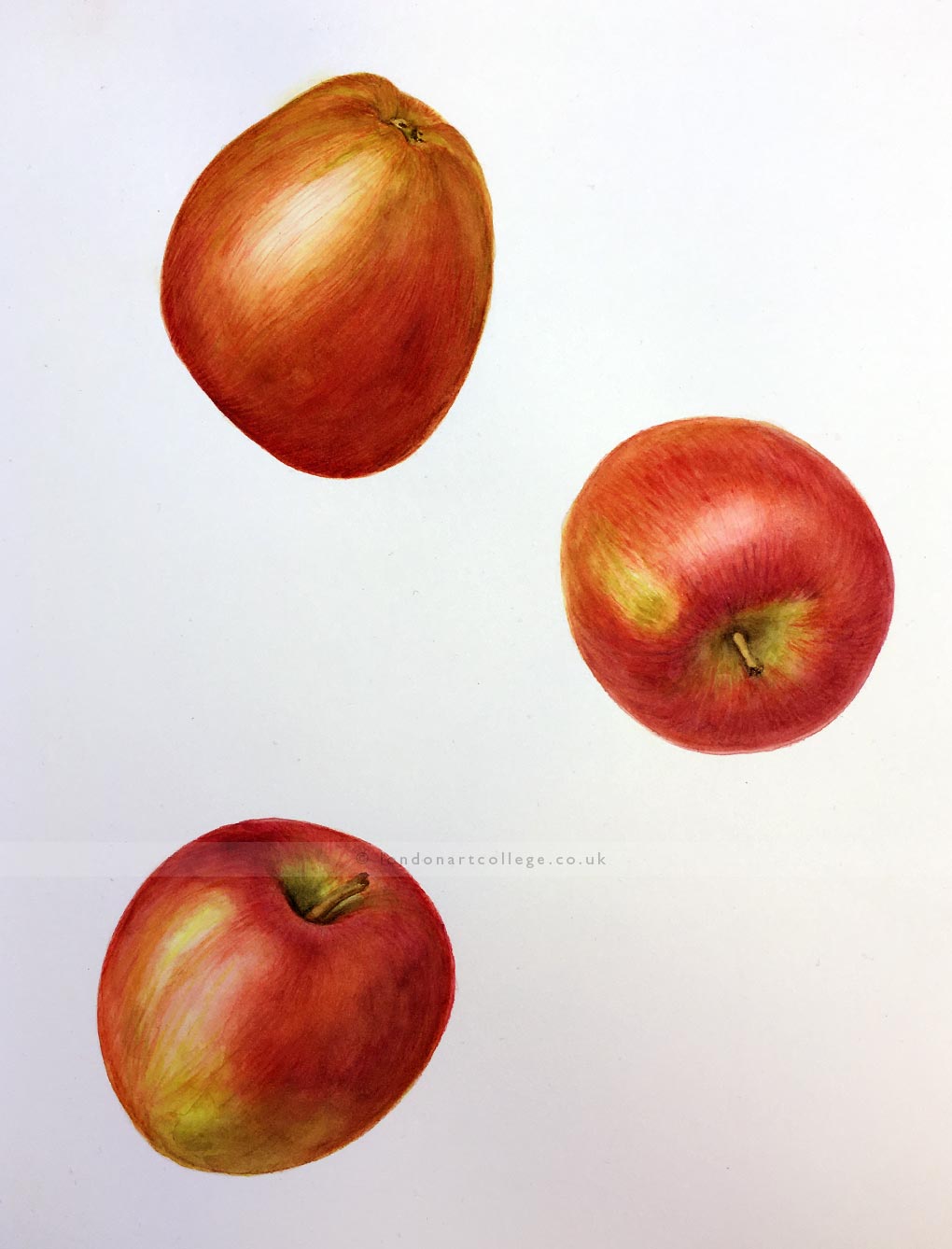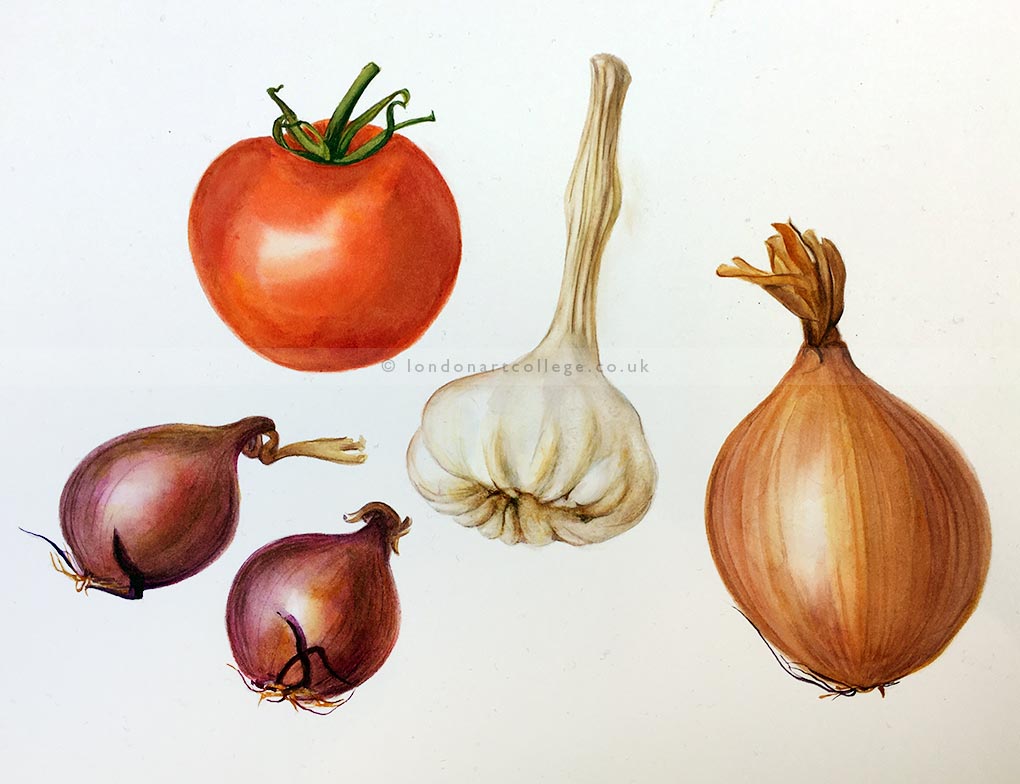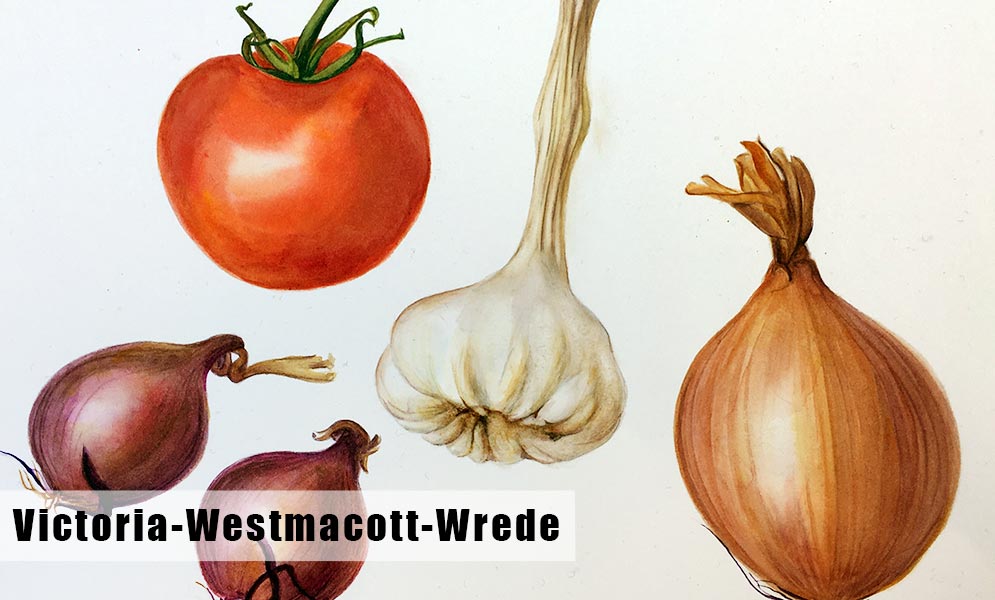Amazing artwork from Victoria who is working with tutor Polly O’Leary on the Botanical Painting Diploma Course Her work is stunning and we decided to add snippets of Victorias text that went along to Polly work, in case budding botanical students were interested in how the studies were painted and which colours were used.
I chose Braeburn apples because they keep well and from these I chose just one apple which I painted from different sides and from different angles. This particular apple had more colour variations than the others which seemed more interesting. The colours – red dominating the apple and some green – were not totally bright, the green even a little bit muddy, with lighter, more yellow, and slightly darker tones. I tried to see the ‘colours underneath the obvious colours’ when I started and these seemed to me a warm yellow.
I began with a glaze of water, leaving out the edges. Into the glaze of pure water I dropped a warm yellow (Sennelier Indian Yellow) over most parts and at the same time a warm red (Sennelier red plus some Sen. Lemon Yellow) on the right side. I distributed them with my brush, keeping the whole plane very light and avoiding the area oft he highlight. Quickly I used a damp, not wet, brush with clear water to pull the colour out towards the edges, so that the edges would remain lighter from the beginning. I also removed some colour with a stiffer brush after it had dried, then reworking the edges to avoid a hard line.

After this initial glaze I deepened the colours with a further glaze and then alternated with glazes and many layers of feathering and drybrushing to build up colour. When this became too stripy I would glaze again to pull everything together. I introduced other mixtures of red, mainly Sen. Alizarin Crimson and later also Sen. Helios Purple, while I introduced a greenish shade to the other parts by mixing Sen. Indian Yellow as well as Sen. Quinacridone Gold with Sen. Phtalo Green to layer greener parts on top of the initial yellow. Later, where the greens are slightly darker, I also put in a hint of Sen. Red to make the green more olive.
At a later stage I added violet into the shaded parts, first Sen. Helios Purple, then Sen. Dioxazine Purple in a wet-into-wet-technique, which immediately turned much too purple. But with a layer of muddy green, mixed as above, on top, the shaded parts received a slight greyish-to brownish tone and appeared rather like the original.
On the whole I am quite happy with my apples. I feel that I have improved a little bit with keeping highlights and with not overworking.

I placed the vegetables on a white paper with the light from the left side and painted them in this position. My aim here was the texture, how the surface feels when one touches the vegetables, as well as keeping highlights and not overworking. Again I saw a warm yellow underneath the red of the tomato and also underneath the colours of the red and golden onions.
Tomato:
I began as with the apples, i.e. glazes of clear water into which I dropped Sen. Indian Yellow and warm red, i.e. Sen. Red plus some Sen. Lemon Yellow, spreading the paint and leaving out the highlights. I did not use feathering or drybrushing at all with the tomato but only wet-in-wet glazes. I began introducing darker red and a hint of purple, as with the apples, but did not dull the purple-red as much as with the apples by adding a hint of green. The green stalk and leaves were built up by first using Sen Yellow with a hint of Phtalo-Green and later darkening the greens with more blue and a bit of red.
Red onions:
These first received a glaze with warm Yellow as above and later I added glazes with warm red (Sen- Red, a tiny bit if Sen.Lemon Yellow added), purples, i.e. Sen. Helios Purple and more so Sen. Dioxazine Purple. Inbetween I used the tip of my brush to put in lines and to give the impression of the stripy texture. Then I glazed over the stripes again. The warm yellow is still visible in he centre and I felt that I also saw this in all onions. The onion on the left has a greyish colour at the top on the left by adding a bit of Sen. Quinacridone Gold. The stalk and some of the roots were also painted with Sen- Quin. Gold,which I broke a little bit with purple on my pallette. The skin of the onions had opened a little bit leaving a crack, which was much darker than the top layer of the skin. I am not sure whether I succeded in showing this…
Golden Onion:
While beginning to paint the apples and other vegetables I ad already discovered that Sen. Quinacridine Gold seemed a wonderful colour for this onion. Nevertheless I again began with a glaze of Sen. Indian Yellow, again I had the impression that this warm yellow should lie underneath further layers. I then continued with glazes and with also adding stripes with the tip of my brush, alternating with glazes. Here I introduced Sen- Quinacridone Gold and I broke this with Sen- Dioxazin Purple in the shadowy parts. The whole onion was really painted with just these three colours, even the bits of leaves at the top.
Garlic:
This was a bit of a challenge and maybe it is not totally successful. Again the texture was important to me. I used little colour compared to the other vegetables, leaving parts almost without colour. There were shadows where the cloves inside the garlic sit as well as a warm yellow on the left side and the stalk also seemed to have a hint of warm yellow with shaddowy lines in the creases. For warm yellow I used Sen. Indian Yellow and this I mixed with Sen. Dioxazin Purple for the grey shadows. The brown underneath the garlic also had some Sen-Quinacridone Gold to mix the brown – so very few colours were used here.
If you would like to receive a roundup of all of our blog posts once a week to keep you inspired in your inbox, why not sign up to our newsletter. You can access our sign up at the top of our page. If you are a London Art College student and you would like your artwork featured here, drop us a line at any time.

